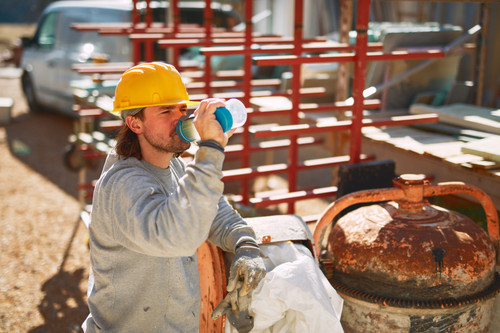What Is the Difference Between Heat Stroke and Heat Exhaustion?
If you and your employees are working outside or in extreme heat, you need to be aware of the dangers of both heat stroke and heat exhaustion. Some business owners may confuse these two terms, but they refer to two different heat-related illnesses. A heat-related illness occurs when a person’s body can no longer cool itself properly. Normally, the body will cool itself down by sweating, but when working in extreme heat, sweating may not be enough. If the person’s body gets too hot, it can lead to brain and organ damage.
Around 618 people die from extreme heat in the U.S. every year. As a business owner or manager, you need to protect your employees from heat-related illnesses using protective clothing and other prevention strategies. Learn about the difference between heat stroke and heat exhaustion, so you can better protect your employees in the field.
What Is Heat Exhaustion?
Heat exhaustion happens before heat stroke. If a person continues to suffer from heat exhaustion without being treated or reducing their body temperature, they will develop heat stroke.
Heat exhaustion can develop when working in extreme heat for long periods. Workers can be more susceptible to heat exhaustion than non-workers as they exert more energy throughout the day and complete various tasks.
Symptoms of heat exhaustion include:
- Heavy sweating
- Cold, pale, and clammy skin
- A fast, faint pulse
- Nausea or vomiting
- Muscle cramps
- General fatigue
- Dizziness or lightheadedness
- Headache or migraine
- Fainting and passing out
If you suspect that you or one of your employees is suffering from heat exhaustion, you’ll need to remedy the situation before it leads to heat stroke. To combat heat exhaustion, you should:
- Move the person indoors, in the shade or to a cool place
- Loosen their clothing to increase the flow of oxygen
- Have them put on cool, wet clothes or take a bath
- Give them plenty of water
If the person is throwing up, passed out, or their symptoms last longer than one hour, you should seek medical attention immediately.
What Is Heat Stroke?
As heat exhaustion persists, a person will eventually develop heat stroke, which is much more serious. Heat stroke is considered a medical emergency and should be dealt with as such. In order for heat stroke to occur, the person’s body temperature will need to 103°F or higher.
Symptoms of heat stroke include:
- High body temperature
- Hot, red, damp or dry skin
- Fast, strong pulse
- Headache
- Dizziness
- Nausea
- Fever
- Confusion or lack of consciousness
- Seizures or even going into a coma
- A lack of sweating despite a high body temperature
Responding to heat stroke is different than heat exhaustion, namely in that it requires immediate medical attention. If the person abruptly stops sweating, loses consciousness, starts vomiting, or their body temperature surpasses 103°F, you should call 9-1-1 immediately and wait for the authorities to arrive on the scene.
While you wait, use the following techniques to lower the person’s body temperature:
- Move them to a cooler place
- Put cool, damp cloths and cooling towels on their body or spray them with cool water
- Do not give them anything to drink if they are unconscious or throwing up. Avoid giving them cold water, which can cause stomach aches
How to Prevent Heat-Related Illnesses
Preventing heat exhaustion and heat stroke is about reducing the person’s body temperature when working in extreme heat. Use the following strategies to keep your employees comfortable when working outdoors:
- Provide plenty of water and encourage them to drink throughout the day instead of waiting until they get thirsty.
- Avoid giving out alcoholic, overly sugary or caffeinated beverages throughout the day.
- Give out sunscreen and reapply according to the instructions on the package. Personal spray bottles, sunscreen lip balm, and sunscreen lotion pouches make it easy for the person to reapply throughout the day.
- Avoid having your employees complete the most strenuous tasks during the hottest parts of the day and reschedule them for the early morning or evening.
- Have them spend time in the shade or air-conditioned spaces during breaks and before work.
Protective Clothing for Heat-Related Illnesses
You’ll also need to supply your employees with protective clothing when having them work in extreme heat. It’s best to have your employees wear loose, lightweight, and light-colored clothing, so they can breathe easily throughout the day. You should also include the following products in your heat exhaustion safety kit:
- Use cooling vests to help them stay comfortable throughout the day
- Evaporative cooling hard hat sun protection will reduce their body temperature. Dip it in cold water for continuous cooling
- Give out wide-brimmed cooling hats with neck shades to prevent sunburn
Keep these products on hand to prevent heat-related illnesses. Teach your employees the warning signs of heat exhaustion and heat stroke and how to respond, so everyone can stay safe when working outdoors.
For more heat-related safety products, visit PK Safety today!
Recent Posts
-
Customizing Gas Detectors: Tailoring Solutions to Fit Your Unique Requirements
In today’s diverse industrial landscape, a one-size-fits-all approach to safety simply doesn’t cu …Jul 3rd 2024 -
10 Ways to Prevent Wildfires
You can prevent wildfires by extinguishing flames before you leave the worksite. Avoid practicing …Jul 1st 2024 -
ANSI/ISEA 138 Safety Gloves: Ensuring Hand Protection
The human hand is an anatomical masterpiece and arguably the greatest tool attached to our bodies …Jun 25th 2024





